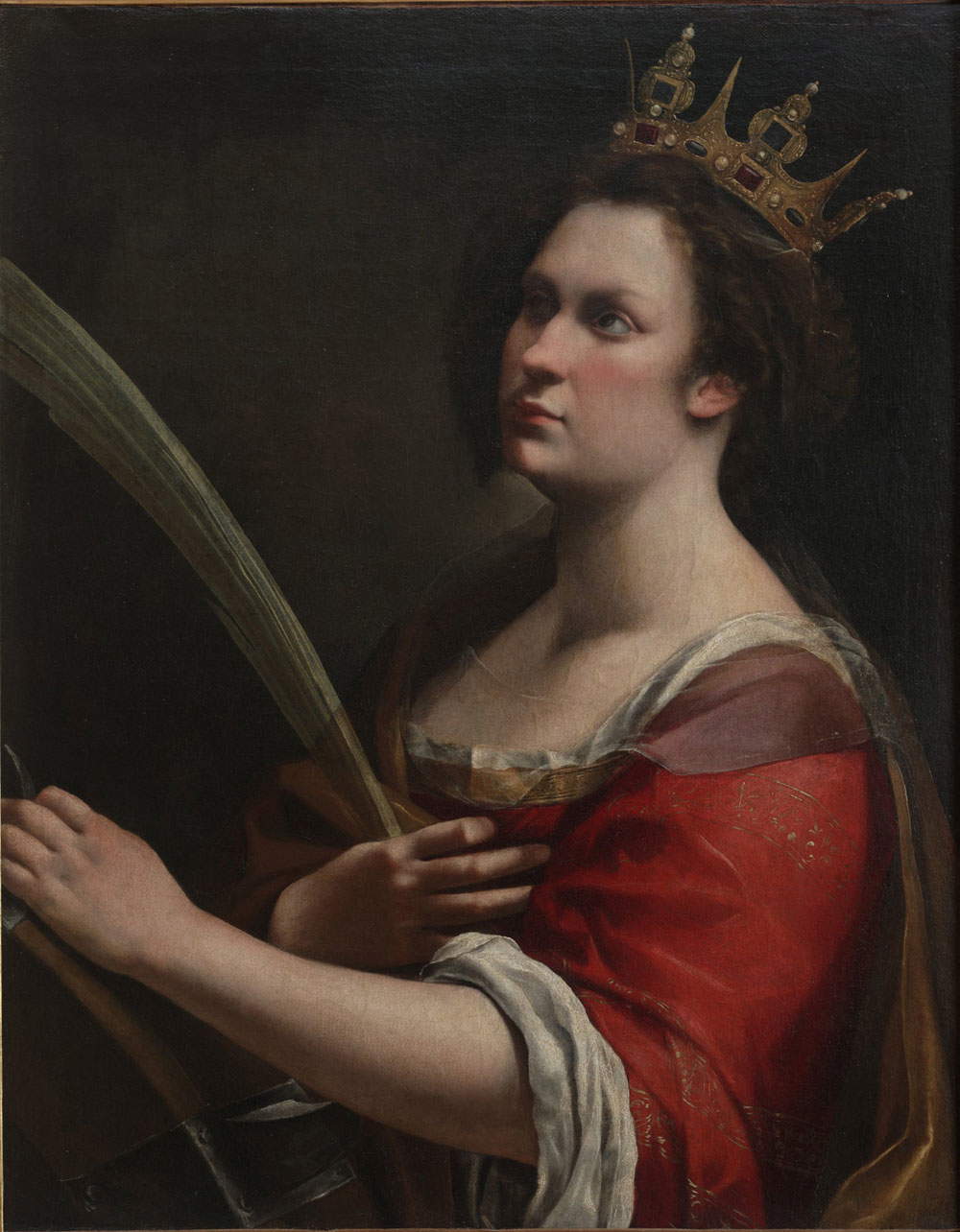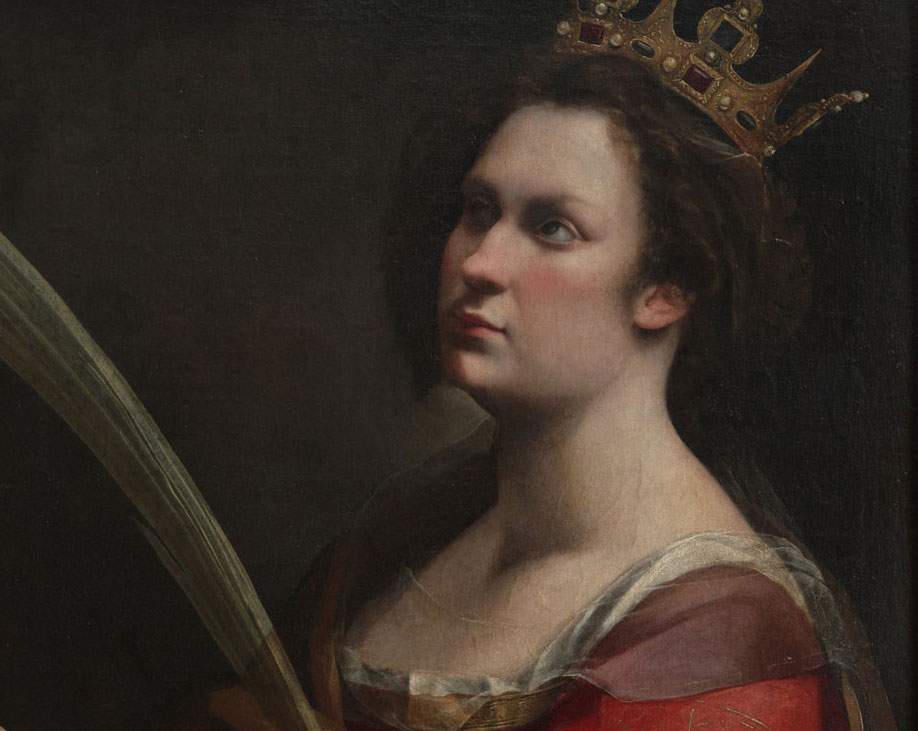Recently concluded analyses of the painting depicting Artemisia Gentileschi’sSt. Catherine of Alexandria by specialists from theOpificio delle Pietre Dure in Florence reveal that the work, owned by the Uffizi Galleries, may be a’mash up,’ a recombination and reworking between thefamous painter’s self-portrait and the portrait of Catherine, daughter of Grand Duke Ferdinando de’ Medici, made during her stay at the court of the Tuscan lords.
The non-invasive investigations, carried out using ultraviolet, infrared and X-rays, lasted about a month, and through them the laborious genesis of this painting was revealed. The study, conducted by Maria Luisa Reginella and Roberto Bellucci under the supervision of Cecilia Frosinini, showed that beneath the surface of the work there is a pre-existing version of St. Catherine, without a crown and wearing a turban, and her face more turned toward the viewer, rather than three-quarter facing and looking upward in contemplation, as it appears in the finished painting.
What revealed these hidden details were above all X-ray examinations: an initial different position of the saint’s left hand, later modified by Artemisia, a veil on the neckline of the dress (equipped with a sort of collar that at first had suggested a male robe, an idea later set aside) and a mysterious small face at the left side of Saint Catherine’s face, completely decontextualized from the finished work or its earlier version, also emerged. For this detail it was only possible to assume that it was an early sketch of an entirely different work, later abandoned. From this it can be inferred that Artemisia reused this started canvas to save on materials. From the analysis of the underlying versions of the Saint Catherine, the restorers drew some important considerations: through virtual superimposition operations, they noted how the version of the martyr with the turban is virtually identical to the Gentileschi work purchased a few months ago from the National Gallery in London. Secondly, based on this reflection, it was hypothesized that both canvases, the one in the possession of the Uffizi and the one in the British museum, derive from the same drawing. On a general level, the results obtained from the Opificio’s studies confirm the thesis that Artemisia habitually used her own image as a model for painting female figures. Not only that: according to the specialists of the prestigious restoration agency, the artist, starting from the basic drawing, may have modified the work by inserting a crown with Medici elements and partially changing the facial features of the saint perhaps in homage to Ferdinand’s daughter, who bore the same name as the saint.
“Catherine, daughter of Ferdinand and sister of Cosimo II, a contemporary of Artemisia, was in those years at the center of the marriage policies of the Medici house; there was in fact an attempt to betroth her to the Prince of Wales and, later, she was given in marriage to Duke Ferdinando Gonzaga of Mantua. The painting may be a tribute to her or perhaps just also inspired by this dynastic figure, at a time when the painter portrays a Saint Catherine different from other versions of the martyr of Alexandria, so strongly connoted by Medici attributes,” said art historian Cecilia Frosinini. And she added, “Once again, having undertaken a diagnostic campaign on a work, even a well-known one, but never approached from this point of view, allows for an enrichment of knowledge and will certainly give scholars, from now on, the cue to reconsider this work in Artemisia’s stylistic path and to be able to better relate it to the other known versions that the artist dedicated to the martyr of Alexandria.”
Back from the Opificio, the Saint Catherine of Alexandria will have a new location: from today, it will be permanently displayed in the Medusa room, where it will ideally dialogue with Caravaggio’s monstrous creature.
“This year we will be able to celebrate Women’s Day with these important revelations, which change what we know about Artemisia, one of the most important painters in all of art history. The skill of the Opificio’s specialists has made it possible to uncover the secrets of our beautiful St. Catherine: and now, thanks to their work, we are happy to be able to say that in addition to the five masterpieces by the artist owned by the Galleries, the Uffizi preserves an additional one, hitherto hidden beneath the visible painting of the Martyr of Alexandria,” commented the director of the Uffizi Galleries, Eike Schmidt.
Source: release
In the images below: the X-ray, a reproduction and a detail of Artemisia Gentileschi’s Saint Catherine of Alexandria.
 |
 |
 |
| Artemisia Gentileschi painting discovered hidden under her Catherine of Alexandria |
Warning: the translation into English of the original Italian article was created using automatic tools. We undertake to review all articles, but we do not guarantee the total absence of inaccuracies in the translation due to the program. You can find the original by clicking on the ITA button. If you find any mistake,please contact us.